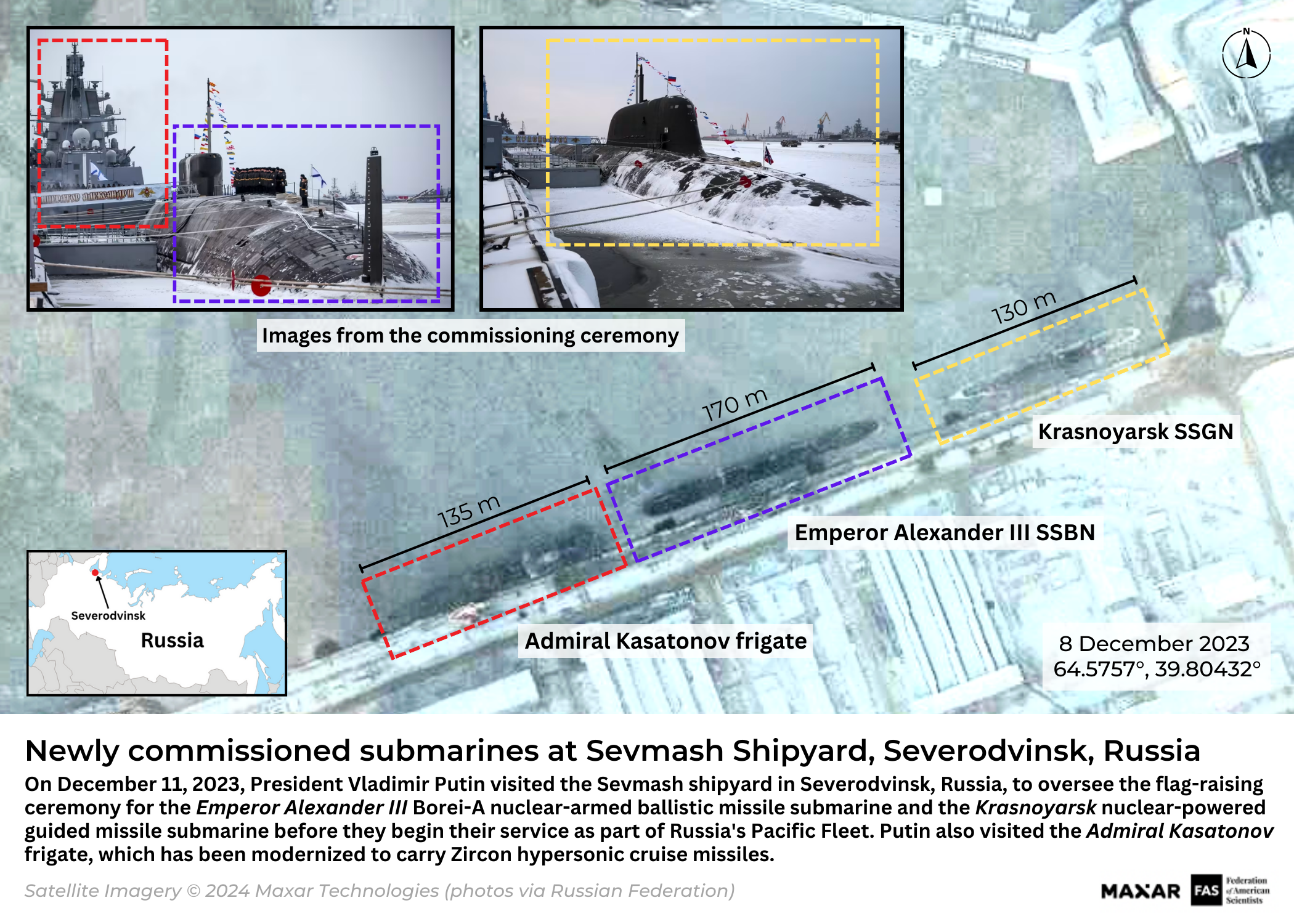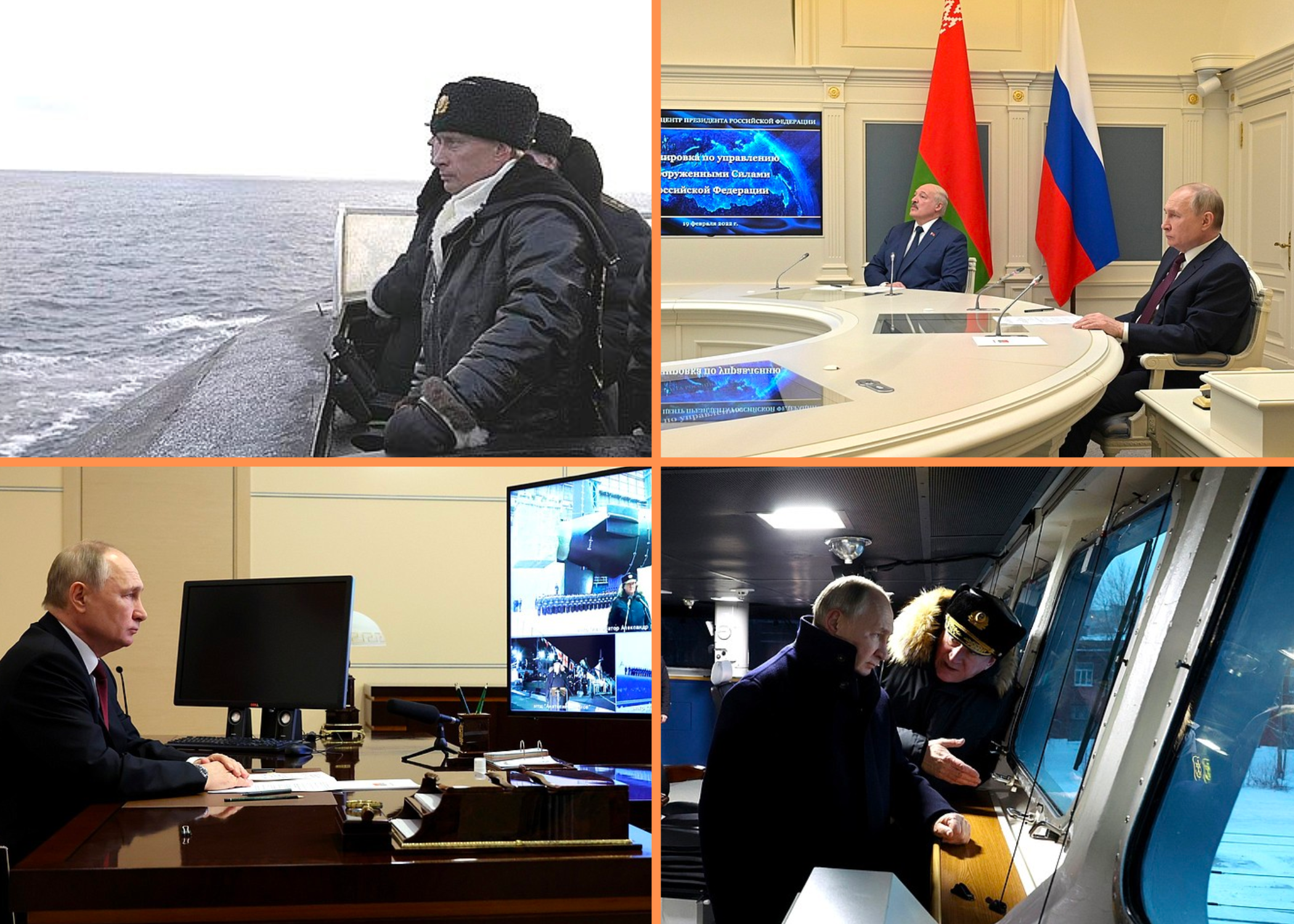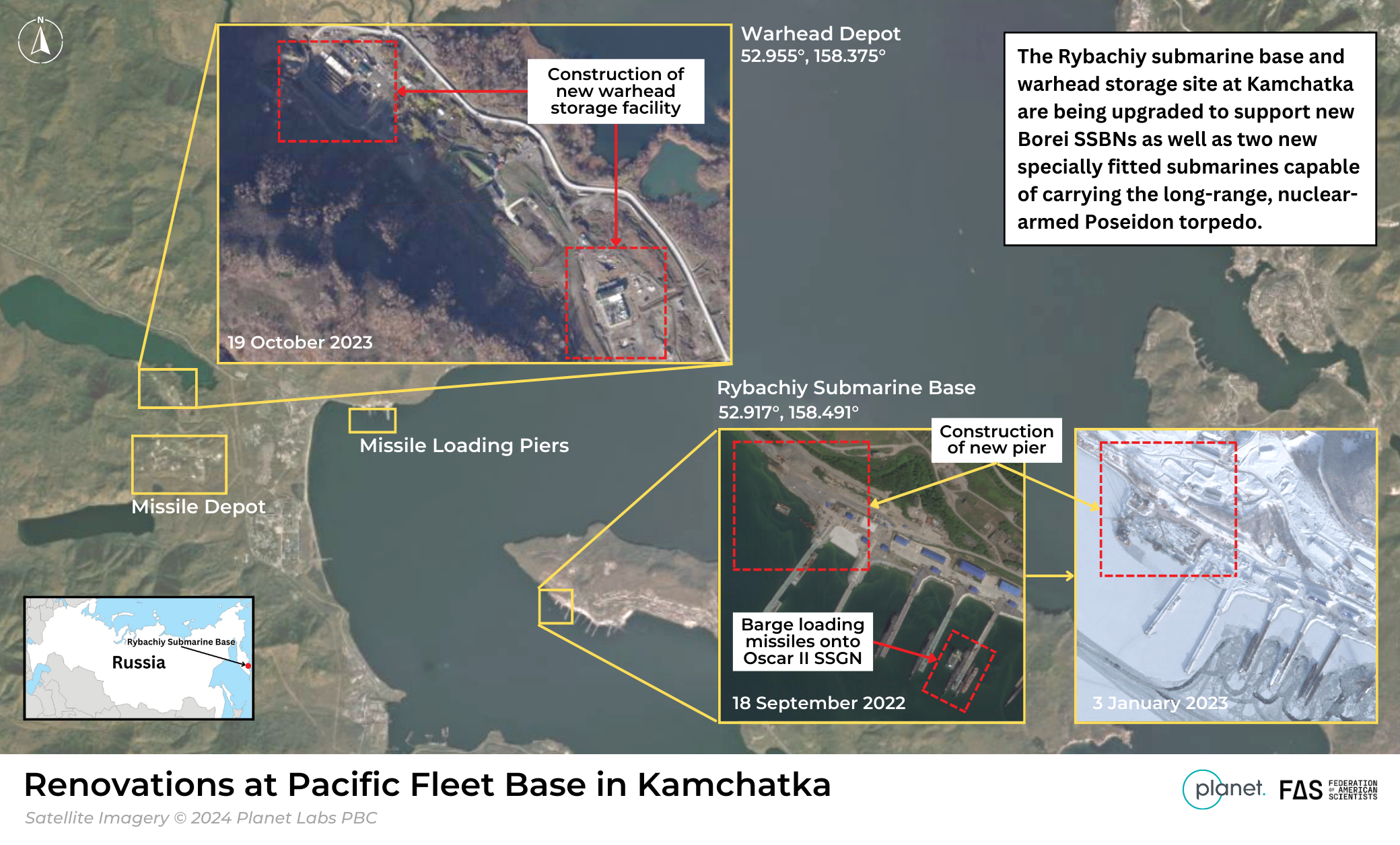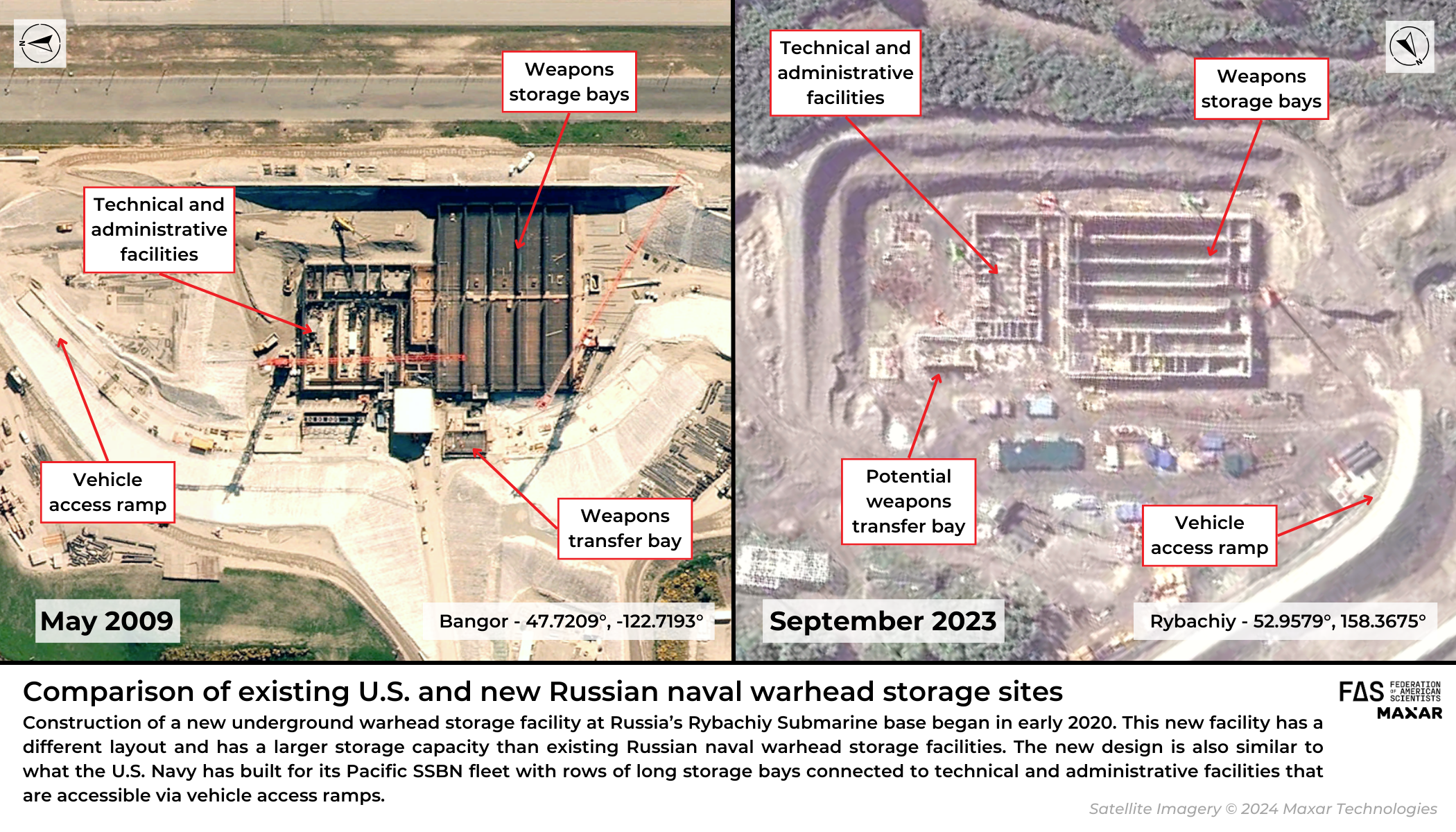
Upgrades to Russia’s Nuclear-Capable Submarine Fleet
[With updated graphic] Russia is in the midst of a decades-long nuclear force modernization program intended to replace Soviet-era missiles, aircraft, and submarines with new systems. As part of this project, Russia’s Navy is currently modernizing its nuclear-powered ballistic missile submarine (SSBN) fleet and building new nuclear-powered guided missile submarines (SSGNs), along with other non-strategic nuclear-capable naval systems. The final delivery of these new strategic and non-strategic submarines to the Northern and Pacific fleets is expected to be complete by the early 2030s. FAS has tracked the progress of these developments as well as the upgrades to the supporting naval infrastructure, including submarine piers, missile loading piers, and new nuclear warhead storage facilities.
Putin commissions new nuclear-capable submarines
On 11 December 2023, Russian President Vladimir Putin traveled to the Sevmash shipyard in Severodvinsk to attend the flag-raising ceremony for two new nuclear-capable submarines. Putin’s trip to Severodvinsk came days after he declared his intention to seek another six-year presidential term.
At the shipyard, Putin oversaw the raising of the Russian Navy’s flag on the newly completed Borei-A Emperor Alexander III (K-554) SSBN and the Yasen-M Krasnoyarsk (K-571) SSGN. Putin also visited the Admiral Kasatonov frigate of Russia’s Northern Fleet, which was recently modernized to carry four Zircon hypersonic cruise missiles. A Maxar Technologies satellite captured preparations for the ceremony at Sevmash three days before Putin’s arrival.

On December 11, 2023, President Vladimir Putin visited the Sevmash shipyard in Severodvinsk, Russia, to oversee the flag-raising ceremony for the Emperor Alexander III Borei-A nuclear-armed ballistic missile submarine and the Krasnoyarsk nuclear-powered guided missile submarine before they begin their service as part of Russia’s Pacific Fleet. Putin also visited the Admiral Kasatonov frigate, which has been modernized to carry Zircon hypersonic cruise missiles.
Unlike many other nuclear–armed states, it is not unusual for Putin to oversee ceremonies or drills relating to Russia’s nuclear forces. He regularly attends flag-raising ceremonies of other nuclear-powered submarines and nuclear force exercises as a signal of strength and confidence in Russian nuclear capabilities. In fact, Kremlin Spokesman Dmitry Peskov stated before a February 2022 strategic deterrence force drill that “such drills and training launches, naturally, can’t be held without the head of state,” referring to Putin’s observance of the exercise.

TOP LEFT: Putin views a strategic command post exercise in the Barents Sea in 2004. TOP RIGHT: Putin and President Belarus Lukashenko observe a February 2022 strategic deterrence forces exercise. BOTTOM LEFT: Putin attends a ceremony in December 2022 to raise the flag on the Generalissimus Suvorov SSBN and launch the Emperor Aleksandr III SSBN. BOTTOM RIGHT: Putin observes the frigate Admiral Kasatonov during the December 2023 commissioning ceremony of the Emperor Aleksandr III ballistic missile submarine and the Krasnoyarsk guided missile submarine.
While it is common for Putin to observe Russian nuclear force exercises and activities, this practice is not as customary in other nuclear-armed states. Leaders of other states will occasionally attend ceremonies or military parades that feature nuclear-capable weapons as a sign of power, but aside from in North Korea, heads of state do not regularly oversee nuclear weapons testing, exercises, and other related activities in person. Putin’s practice of uniquely observing these nuclear force drills or the commissioning of strategic weapons is presumably intended to signal the centrality of Russia’s nuclear weapons in its military doctrine.
Russian submarine fleet modernization
Submarines play a key role in Russia’s deterrence strategy, given that their stealth and survivability provide an important second-strike capability. The recent commissioning of new nuclear-powered submarines into the Pacific Fleet is a part of a larger modernization campaign as Russia’s older submarines begin to reach the ends of their service lives.
The Russian Navy currently operates two classes of SSBNs: five Delta IV (Project 667BRDM Delfin) and eight Borei (Project 955/A), five of which are the improved Borei-A (Project 955A) variant. The Emperor Alexander III––the submarine that Putin observed in December––is the seventh Borei-class submarine to enter service and the fourth of the upgraded Borei-A type. The Emperor Alexander III will be based with the Pacific Fleet located in the Kamchatka Peninsula.
Two additional Borei-A SSBNs are currently under construction, and two more are thought to be in the planning stages. Eventually, it is expected that six Borei SSBNs will be assigned to the Northern Fleet based in the Kola Peninsula, and six will be assigned to the Pacific Fleet. The new generation of Borei SSBNs will replace the Soviet-era Delta IV submarines, which are scheduled to be decommissioned throughout the late-2020s and early-2030s.
Each Borei submarine is capable of carrying 16 Bulava (SS-N-32) submarine-launched ballistic missiles (SLBMs), which can carry up to six warheads each. However, it is likely that each missile has been downloaded to four warheads to comply with the New START limit on deployed strategic warheads. Although President Putin “suspended” Russia’s participation in New START in February 2023, Russian officials subsequently stated that Russia would continue to abide by the treaty’s central limits; if so, these SLBMs presumably still carry a reduced number of warheads. This limit falls away when the New START treaty expires in February 2026 unless it is replaced with a new agreement.
A possible next generation Russian strategic nuclear submarines concept – known as “Arktur” or “Arcturus” – was unveiled at the “Army 2022” International Military-Technical Forum and could potentially start replacing the Borei-class submarines sometime after 2037. Notably, an industry official said the Arktur-class will be smaller than the current Borei-class and have a reduced number of ballistic missiles. The design concept appears to allow the submarine to also carry other weapons as well as an unmanned underwater vehicle, which would imply a multi-mission role. New SSBN variants will also likely be equipped with reactor technology that extends the amount of time required between refueling, which will significantly shorten midlife maintenance operations and allow for more submarines to be on patrol at the same point in time.

In addition to strategic SSBNs, the Russian Navy operates sea-based nonstrategic nuclear weapons, including land-attack cruise missiles, anti-ship cruise missiles, torpedoes, and more, which can be launched from naval systems such as aircraft carriers, cruisers, frigates, corvettes, naval aircraft, and guided missile submarines such as the Krasnoyarsk––the other submarine that Putin observed in December.
The Russian Navy is also building submarines specially configured to carry a new nuclear-powered, long-range, nuclear-armed torpedo called Poseidon. The first of these submarines—Project 09852 Belgorod (K-329)—was delivered to the Russian Navy in July 2022 and reportedly will be capable of carrying up to six Poseidon torpedoes. The second submarine—Project 09851 Khabarovsk—is in the final stages of construction at the Sevmash Shipyard and will also reportedly carry up to six Poseidon torpedoes. One more specially configured submarine is planned to be delivered to the Russian Navy by 2027, for a total of at least three Poseidon-capable submarines.
Upgrades to Pacific Fleet infrastructure
A new division of specially configured submarines will reportedly be stationed with the Pacific fleet by the end of 2025. To support this expansion, as well as the additions of the Krasnoyarsk, Emperor Alexander III, and eventually more Borei submarines, infrastructure at the Pacific Fleet naval base in Kamchatka is undergoing significant renovations. In the past several years, Russia has added additional storage at the missile and warhead depots and begun construction of a new pier. These projects can be seen from satellite imagery captured by Planet Labs PBC.

The Rybachiy submarine base and warhead storage site at Kamchatka are being upgraded to support new Borei SSBNs as well as two new specially fitted submarines capable of carrying the long-range, nuclear-armed Poseidon torpedo.
While upgrades to the existing warhead storage facilities at the Rybachiy submarine base in Kamchatka began sometime after August 2013, construction of a new underground warhead storage facility began in early 2020 and is ongoing. The existing storage facility was built to accommodate warheads for now-decommissioned Delta III submarines, but those missiles could only carry three warheads on each missile. Since the new Borei SSBNs will be able to carry up to six warheads on each of its 16 SLBMs, the new facilities are likely meant for the Pacific Fleet to accommodate additional warheads as Russia completes the modernization of the submarine fleet in the coming years.
This new storage addition is also particularly interesting because of its unique design – the facility has a different layout than existing Russian naval warhead storage facilities in the Pacific and Northern Fleets and seems to be designed similarly to what the U.S. Navy has built for its Pacific SSBN fleet.

Construction of a new underground warhead storage facility at Russia’s Rybachiy Submarine base began in early 2020. This new facility has a different layout and has a larger storage capacity than existing Russian naval warhead storage facilities. The new design is also similar to what the U.S. Navy has built for its Pacific SSBN fleet with rows of long storage bays connected to technical and administrative facilities that are accessible via vehicle access ramps.
This research was carried out with generous contributions from the New-Land Foundation, Ploughshares Fund, the Prospect Hill Foundation, Longview Philanthropy, and individual donors.
The FY2026 National Defense Authorization Act (NDAA) paints a picture of a Congress that is working to both protect and accelerate nuclear modernization programs while simultaneously lacking trust in the Pentagon and the Department of Energy to execute them.
While advanced Chinese language proficiency and cultural familiarity remain irreplaceable skills, they are neither necessary nor sufficient for successful open-source analysis on China’s nuclear forces.
Satellite imagery has long served as a tool for observing on-the-ground activity worldwide, and offers especially valuable insights into the operation, development, and physical features related to nuclear technology.
This report outlines a framework relying on “Cooperative Technical Means” for effective arms control verification based on remote sensing, avoiding on-site inspections but maintaining a level of transparency that allows for immediate detection of changes in nuclear posture or a significant build-up above agreed limits.